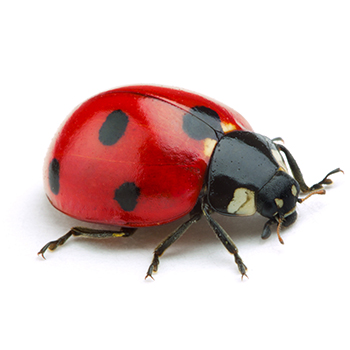Get Rid of Ladybugs

Purchasing a home or owning a business in New Jersey, Maryland, Pennsylvania, or Delaware is a life milestone. It requires care and dedication, and can often include necessary upkeep like pest removal. Removing pests before they cause structural or cosmetic damage to your dwelling or business is exceptionally important. Although ladybugs may not look like pests, they can swarm in large numbers, eat the leaves off garden plants, and invade homes in hopes of finding a warm refuge for winter. Ladybugs can be pleasant to look at outdoors, but it’s essential to get rid of ladybugs when they infest your home or business.
To protect your home or business from ladybugs, you need to learn about the behavior of this pest, take steps for prevention, and find effective treatment options should an infestation occur.
What are Ladybugs?
In New Jersey, Pennsylvania, Maryland, and Delaware, species of ladybugs can be divided into two categories: native and non-native. The most common native species of ladybug is the convergent ladybug (Hippodamia convergens), which can be found throughout the United States. There are very few native species of ladybugs left because they have largely been displaced by non-native species, including the Asian lady beetle.
The Asian lady beetle (Harmonia axyridis) is considered much more aggressive than the convergent ladybug and can be found in homes when small cracks, vents, or other openings have been left unattended. All types of ladybugs can be useful in gardens, where they eat other pests like aphids who feast on trees and plants, but in large numbers in homes or businesses, they become pests themselves.
How Do I Identify Ladybugs?
Ladybugs are small red or orange insects that range in size between 1/4 to 3/4ths of an inch. Ladybugs have a shiny domed back that covers a set of filmy wings with a series of black spots on their wings. Each species of ladybugs – including Asian lady beetles – has a unique number of spots, ranging from zero up to 22.
It can be difficult to tell Asian lady beetles and native ladybugs apart, but if you look closely there are a few important differences. Pest control experts explain Asian lady beetles tend to be longer and their color varies between deep red and lighter orange. These beetles also have whiter heads than native ladybugs, who only have small white spots towards the outside edge of their head. When exposed to predators, ladybugs will retreat, while Asian lady beetles emit a smelly yellow liquid from their legs in response to threats.
How Do I Get Ladybugs?
Ladybugs are prized by farmers and gardeners because of their appetite for insects like aphids and whiteflies that can damage plant leaves. Ladybugs rarely congregate in large groups, and will always seek shelter in cold weather.
To escape the cold as winter sets in, Asian lady beetles often congregate around the warm surfaces of homes and businesses. Exterminators explain it’s common to find ladybugs in siding, under roof shingles, in door frames, and other dark, undisturbed corners. If the Asian lady beetles are not removed gently, the yellow liquid they emit can stain walls and fabric. This liquid can also mark territory encouraging other Asian lady beetles to visit.
What Are the Effects of Ladybugs in and around My Home or Business?
Fortunately, Asian lady beetles and other species of ladybugs that enter your home or business do not cause damage to anything while they’re alive. Pest control experts state these insects are simply seeking a cozy shelter. They gravitate towards warm attics, quiet basements, or cluster in walls. In businesses, they can frequently be found in drop-down ceilings, light fixtures, or window sills.
Even though ladybugs and Asian lady beetles are not harmful, sharing your home or business with an insect pest is unsanitary and unpleasant. Trying to remove them on your own can often result in unsightly yellow stains on light-colored fabric and walls. These threat-related secretions can also cause allergic reactions when contact is made with bare skin. If you’re overrun by ladybugs at your business, it can drive customers away. No business or homeowner in New Jersey, Pennsylvania, Maryland, or Delaware wants to share its space with invasive insects.
How Do I Prevent Ladybugs?
The easiest way to prevent ladybugs and Asian lady beetles from invading your New Jersey, Pennsylvania, Delaware, or Maryland home or business is to ensure there are no cracks for them to enter through. Controlling the local insect population is an impossible task, so the best you can do is prevent them from choosing your home or business as a shelter.
Exterminators suggest caulking over cracks and crevices in the siding, windows, and doorways of your home. Replace roof tiles or shingles that have become loose or damaged. Check over pipes that reach outside the building, and ensure the seal is tight. Make sure all the windows and doors fit tightly in their frames. If you like to leave the door open to catch a breeze, it may be worth investing in screens to prevent insects from flying inside.















